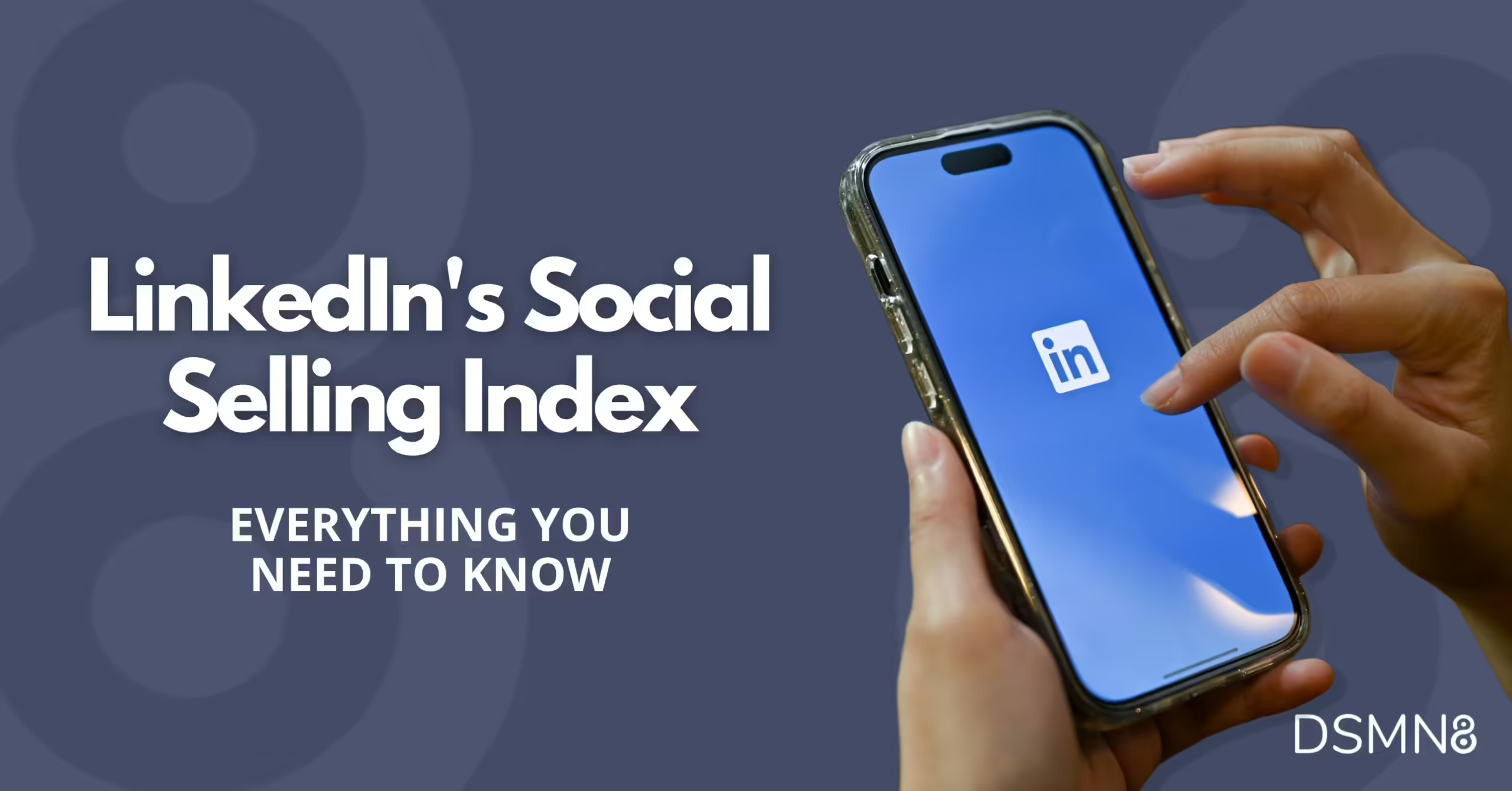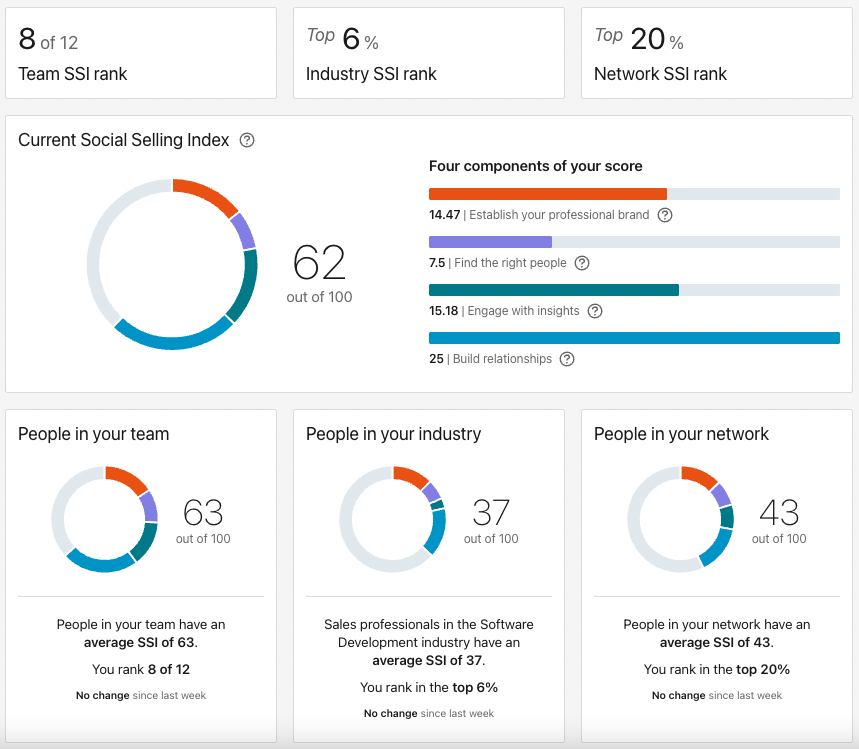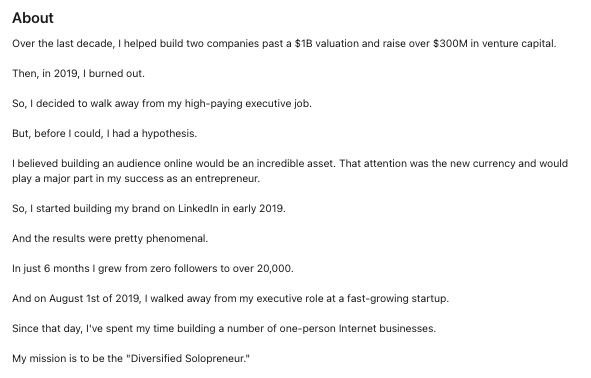
Last updated: 17th May 2024.
First launched back in 2003 as a place to find and share job positions, LinkedIn has become the world’s largest professional social media network. As of 2024, LinkedIn’s community stands at over 1 billion users in 200 countries.
This vast network provides a huge opportunity for both businesses and individuals, enabling you to build relationships online in a professional context.
So it’s no surprise that LinkedIn has become the ultimate platform for salespeople, especially in the B2B sector. With tools like Sales Navigator, it’s easier than ever to reach decision makers in the organizations you’re targeting, by using advanced filtering capabilities.
But how can salespeople find out how their efforts compare with their competitors, their industry, and even their colleagues?
Enter LinkedIn’s Social Selling Index.
Launched in 2014, the Social Selling Index (abbreviated to SSI) provides a score that reveals your social selling performance, and crucially, how this compares to others.
Whether you work in a sales function or not, if you’re building a network on LinkedIn, your SSI shouldn’t be ignored.
Here’s everything you need to know about the LinkedIn Social Selling Index, how it’s calculated, and tips for improving your score.
What Is Social Selling?
Let’s take a step back for a second.
What exactly is social selling?
LinkedIn defines social selling as: “a strategic method for sellers to connect and build relationships with prospects through social networks”.
Social selling isn’t simply sales on social media. It’s an approach that includes both sales and marketing. For a salesperson to increase their visibility on social media, they’ll need quality content to share with their audience.
The key elements of building a successful social selling strategy at your organization include:
- Encouraging original employee-generated content for authenticity.
- Ensuring employees know how to optimize their LinkedIn profiles for increased reach and engagement.
- A clear understanding of who you’re targeting, and what content will attract those people.
Companies that focus on social selling often use additional technology like an employee advocacy platform, to ensure that their team are consistently sharing valuable content to build their social media presence. This helps them reach the right people, and be front-of-mind when a prospect is ready to buy.
What Is The LinkedIn Social Selling Index (SSI), and Where Can I Find It?
Previously, SSI was only be available to Sales Navigator customers, but now everyone can view their score for free.
This is a great move from LinkedIn, to help users get the most from their platform. Following recent algorithm changes, senior managers at LinkedIn revealed that they don’t want viral content on LinkedIn, but instead, niche content that provides valuable insights.
More recently, LinkedIn have updated their Link Preview Images, with the aim to keep users on the site for longer. This makes zero-click content even more important for generating engagement and reach on LinkedIn.
To succeed with social selling on LinkedIn, it’s more important than ever to understand your audience. Instead of casting a wide net, you’ll need to be hyper-focused on your industry / area of expertise.
Thankfully, LinkedIn’s Social Selling Index provides a key indicator on how well you’re performing.
How To Find Your LinkedIn Social Selling Index Score:
To check your SSI score, all you need to do is make sure you’re logged into LinkedIn, then head to this page.
Tip: Bookmark the page to check it regularly! It updates daily.

OK, so you’ve checked your SSI score. But how do you know if it’s good? What does it even mean?
Here’s what you need to know:
The LinkedIn Social Selling Index Score is a number out of 100. In my example above, the user has a score of 62. It’s not bad, but there’s opportunity for improvement.
What’s a good SSI score?
A score of 70+ is great, 40-69 is good, and under 40 isn’t ideal.
LinkedIn recommends aiming for a score of 75, to establish yourself as an industry thought leader.
To really stand out, you’ll want to aim to rank in the top 10% in your industry.
Your 100 potential SSI points are split into 4 components. These are: establish your professional brand, find the right people, engage with insights, and build relationships. I’ll cover these in more detail in the next section.
In my example, this person has a full 25 points for building relationships, but only 7.5 for finding the right people.
This could be for several reasons, such as having many connections from university, or from a career change.
From checking their SSI score, this individual will now understand which areas they should work on to make the most from LinkedIn.
A useful feature of the Social Selling Index is that it doesn’t just reveal your score. LinkedIn compares your performance with the people in your company, in your industry, and in your network.
Looking back to the example score, this person is currently 8 out of 12 in their team. But, comparing to their industry average of 37/100, they’re flying ahead with 62. This makes them in the top 6% of their industry!
Comparing team members’ scores is a great way to incite friendly competition, and understanding how the rest of your industry are ranking puts this data into perspective.
Keep this in mind: the Social Selling Index is designed for salespeople. While it is useful for marketers or recruiters too, their scores will almost certainly be lower than your sales team.
This is because it analyzes metrics that people who don’t work in sales may be not be focused on – for example, reaching out and connecting with prospects.
Let’s dive deeper into the 4 components of your SSI score 👇
LinkedIn Social Selling Index Explained: The 4 Key Factors

1. Establishing a Professional Brand
Complete your profile with the customer in mind. Become a thought-leader by publishing meaningful posts.
This one is all about how you present yourself on LinkedIn: your profile, and your content.
Is your LinkedIn bio complete and up-to-date?
Do you share your own industry insights with thought leadership content?
Are you adding your own opinion to the articles you share?
2. Finding the Right People
Identify better prospects in less time using efficient search and research tools.
This component covers LinkedIn’s search and targeting functionalities, such as filters.
Inevitably, paying users of Sales Navigator will have a higher score here.
3. Engaging with Insights
Discover and share conversation-worthy updates to create and grow relationships.
This one covers content again, but under a slightly different lens:
Does your content drive discussion?
Do you respond to comments and messages, continuing conversations?
4. Building Relationships
Strengthen your network by finding and establishing trust with decision makers.
The final component considers the strength of your network.
This factors in the size of your LinkedIn network and their industry relevance.
It also considers the seniority of those you’re connected with: are they decision-makers?
How To Improve Your LinkedIn Social Selling Index Score
Time for the big question: how do I improve my LinkedIn Social Selling Index Score?
I’m going to break these down by the 4 components again. Each of these elements accounts for 1/4 of your overall score.
If you’re struggling with one part or all of them, following these tips will give your SSI score a boost.
But why bother trying to increase your score?
A higher SSI score will increase your reach on LinkedIn. While it’s not necessarily a key part of the LinkedIn algorithm, focusing on these 4 key areas will improve your presence overall, and consequently scale your visibility.
People with higher SSI scores typically receive more connection requests. Plus, establishing yourself as a thought leader makes it easier to build relationships with decision-makers in your industry.
According to LinkedIn, those with higher social selling index scores:
- Generate 45% more opportunities.
- Are 51% more likely to reach sales quotas.
- And outsell peers who don’t use social media by 78%.
Those stats are reason enough to put in the time to level up your score!
1: Establishing a Professional Brand
Your professional brand is how you present yourself at work, both online and offline.
On LinkedIn, this will cover things like your writing style and tone-of-voice, imagery (profile picture and cover image), and your about section.
Rather than simply listing your job title and previous positions, use storytelling. How did you get to where you are now? What makes you most excited in your role? Are there any standout projects you worked on?
Show your human side! It helps your network get to know you better, and builds trust.
If you need some inspiration, check out Justin Welsh, one of the biggest LinkedIn influencers, and personal branding expert.
Below is a snapshot of Justin’s LinkedIn bio, where he showcases his business experience and results.
Notice that Justin makes it personal by revealing the reason why he became a solopreneur – from experiencing burnout.
To take this approach for your own profile, think about your career path and what led you to where you are today.
Consider what your values are, and how these relate to the work you do.
Don’t forget to add your own tone-of-voice (while remaining professional) to any content you share on LinkedIn. Your audience want to hear from you, so be sure to add your own insights and perspective where possible.
If you haven’t already, follow this step-by-step guide to optimizing your LinkedIn profile. It’s one of the quickest ways to level up your personal brand!
2: Find the Right People
This is where building your ideal client profiles or buyer personas becomes essential.
Whether you work in sales or not, understanding who you should be connecting with is essential.
Before sending or accepting a connection request, consider:
- What organization they work for. Does your company target this industry?
- What department they work in. Do you sell a product primarily used by HR professionals? If so, they’re who you want to network with.
- Their seniority. A senior marketing manager is more likely to be a decision-maker than a marketing asssistant.
To reach these people organically, create content targeted to them and use relevant hashtags.
If you have access to Sales Navigator, make use of the filters and lead suggestions to find your ideal clients efficiently.
Something else to consider before sending out those connection requests: are they active on LinkedIn?
Prioritize networking with people who share content on LinkedIn themselves. Leave insightful comments, and look at the types of content they engage with to find inspiration for your own posts.
Follow industry hashtags to see more relevant content on your feed, and use LinkedIn’s search filters to find people in your ICP who have been active on LinkedIn in the past 30 days.
3: Engage with Insights.
Now you’ve followed relevant industry hashtags and used LinkedIn filters to find the right people, it’s time to engage with their content.
Don’t leave generic comments like ‘great post’. It’s annoying and spammy.
Instead, add your own insights based on your knowledge or experiences. Remember it’s ‘engage with insights’, not just ‘engage’.
This rule applies to your own content too. Rather than just sharing latest industry news articles or company blog posts, add your own insights and opinions to these posts.
Start discussion in the comments section by asking questions, and always reply to the comments you receive.
Regularly check your LinkedIn analytics to monitor impressions and engagement: the key to succeeding here is to increase the engagement on your own content. This indicates to the algorithm that your content is valuable and worth distributing further.
4: Build Relationships.
Think of this as a culmination of the previous 3 factors.
Once you optimize your LinkedIn, find the right people, engage with them, and offer valuable content of your own…
You’ll be well on the way to building professional relationships on LinkedIn.
It’s important to note here that LinkedIn’s description of this component does specify ‘decision makers’.
Your goal is to build trust by sharing thoughtful insights, demonstrating your expertise.
This will help you reach those decision makers, i.e. people in leadership positions.
The 2024 LinkedIn and Edelman B2B Thought Leadership report revealed that 54% of C-Suite executives spend over an hour a week consuming thought leadership content.
75% of them said a piece of thought leadership has led them to research a product or service they were not previously considering.
Decision-makers are actively seeking out thought leadership on LinkedIn, and this content is directly generating business results.
How Employee Advocacy Software Improves Social Selling on LinkedIn
I touched on employee advocacy software above, but how does it improve social selling, and consequently, your social selling index score?
Organizations seeking to maximize social selling on LinkedIn need to do these 3 things:
- Get your team, especially salespeople, to maintain an active presence on LinkedIn.
- Provide relevant, quality content for employees to share. This content shouldn’t be entirely company content. Include third-party industry news, and employee-generated company culture content too.
- Monitor results with analytics to demonstrate the impact of this activity to leadership, and maintain buy-in.
The trouble is, salespeople are very busy. Whether it’s taking calls, reaching out to prospects, or firing off emails, their days are typically jam-packed.
And while many salespeople are great at creating social media content, not all of them are.
This is where an employee advocacy platform becomes your silver bullet.
DSMN8 not only provides a place for employees to find and share your content, but it includes automation features too.
This makes it easy for salespeople to maintain an active LinkedIn presence. They can regularly share relevant content with their audience, with minimal effort required.
Additional Resources
Need some help creating content that works on LinkedIn?
Check out the two-part podcast episode by DSMN8 CEO Bradley Keenan and Senior Marketing Manager, Lewis Gray.
They cover everything you need to know about the recent LinkedIn algorithm changes, and provide a masterclass on creating excellent LinkedIn content.
Part 1:
Part 2:
Bradley also wrote a book, Employee Advocacy: 101 Cheat Codes.
It covers over 100 actionable tips for launching, managing, and scaling your employee advocacy program.
We have a limited number of free physical copies of the book, so make sure to register your interest if you’d like one!
New To Employee Advocacy?
We’ve created a bunch of resources and templates to help get your employees more active on social media.
Whether you’re just launching an employee advocacy program, or you’ve been managing one for a while, you’ll find something helpful in our Resource Hub and Templates Gallery.
Here are some top picks:
Ready to get started with the #1 employee advocacy platform?
Wondering how active your team already is, and how this compares with your competitors?
Emily Neal
SEO and Content Specialist at DSMN8. Emily has 10 years experience blogging, and is a pro at Pinterest Marketing, reaching 1 million monthly views. She’s all about empowering employees to grow their personal brands and become influencers.



